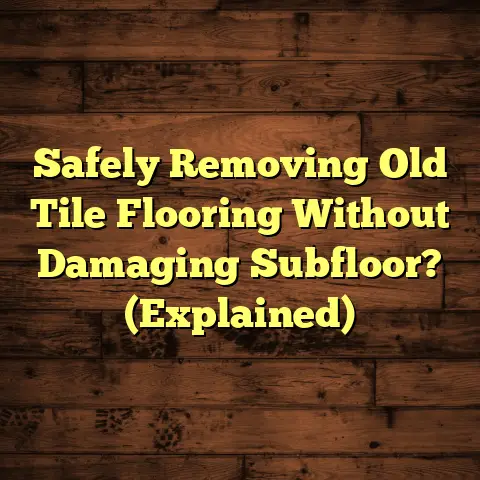Marble Cheaper Than Tile? (2 Shocking Price Drops!)
Imagine stepping into your home after a long day, and the first thing you notice is the floor beneath you.
It’s not just any floor; it’s a gleaming expanse of polished marble, reflecting the soft, warm light.
Suddenly, you’re transported to a luxurious spa or a chic boutique, a world away from the daily grind.
That’s the power of marble: it instantly elevates any space, adding a touch of elegance and sophistication.
But what if I told you that achieving this level of luxury is now more affordable than you think?
What if I said that marble, once considered an unattainable dream, is now within reach?
In fact, in some cases, it can even be cheaper than your standard tile! Sound too good to be true?
Well, buckle up, because I’m about to share two shocking price drops that are changing the game.
The Traditional Perception of Marble vs. Tile
For years, marble has been synonymous with luxury. Think grand palaces, opulent hotels, and high-end homes – marble was the material of choice for those who wanted to make a statement.
Tile, on the other hand, was often seen as the practical, budget-friendly option. It was durable, easy to clean, and came in a wide range of styles and colors. It was the workhorse of the flooring world, reliable and unassuming.
This perception was largely driven by the cost of marble. Traditionally, marble was more expensive than tile due to the complex and labor-intensive process of quarrying, transporting, and finishing the stone.
Think about it: marble quarries are often located in remote areas, requiring specialized equipment and skilled workers to extract the stone. Then, the raw blocks need to be transported to processing facilities, where they are cut, polished, and sealed to perfection. All of this adds up, making marble a premium product with a premium price tag.
Consumers naturally assumed that marble was out of their reach, opting for tile as a more affordable alternative. But the market is changing.
Thanks to some game-changing advancements, the price of marble has been steadily decreasing, challenging the traditional perception and making it a viable option for a wider range of homeowners.
The Shocking Price Drop #1 – Advances in Marble Extraction and Processing
So, what’s behind this first shocking price drop?
The answer lies in the incredible advancements in marble extraction and processing technology.
Over the past few decades, the industry has undergone a massive transformation, driven by innovation and a desire to make marble more accessible.
One of the biggest breakthroughs has been in quarrying techniques. Gone are the days of laborious manual extraction. Modern quarries now utilize sophisticated machinery, such as diamond wire saws and hydraulic splitters, to extract marble with greater precision and efficiency.
These machines can cut through massive blocks of marble in a fraction of the time it used to take, reducing labor costs and minimizing waste.
But the advancements don’t stop there. The processing of marble has also become much more efficient. Automated polishing lines, for example, can produce a perfectly smooth and consistent finish with minimal human intervention.
These lines use a series of rotating heads fitted with diamond-impregnated pads to grind and polish the marble surface. The process is carefully controlled by computers, ensuring a uniform finish every time. This level of automation has significantly reduced the time and labor required to produce finished marble tiles and slabs.
I’ve seen firsthand how these advancements have impacted the price of marble. For example, Carrara marble, a classic Italian marble known for its elegant white background and subtle gray veining, used to be one of the most expensive options on the market.
But thanks to improved quarrying and processing techniques, the price of Carrara marble has dropped significantly in recent years.
I recently worked on a project where we were able to install Carrara marble flooring in a client’s bathroom for about the same price as high-end porcelain tile. The client was thrilled with the result, and I was amazed at how affordable marble had become. These advancements have truly leveled the playing field.
The Shocking Price Drop #2 – The Rise of Engineered Marble
Now, let’s move on to the second shocking price drop: the rise of engineered marble.
Engineered marble, also known as cultured marble or composite marble, is a man-made material that replicates the look and feel of natural marble. It’s made by combining marble chips or dust with resins, pigments, and other additives. The mixture is then molded and cured to create a solid slab or tile.
The beauty of engineered marble is that it offers a number of advantages over natural marble.
First and foremost, it’s significantly more affordable. Because it’s manufactured in a factory setting, engineered marble doesn’t require the same labor-intensive extraction and processing as natural marble.
This translates into lower production costs, which are then passed on to the consumer.
Engineered marble also offers greater design flexibility. Manufacturers can control the color, pattern, and texture of the material, allowing them to create a wide range of styles to suit different tastes and budgets.
You can find engineered marble that perfectly mimics the look of rare and expensive natural marbles, such as Calacatta or Statuario, at a fraction of the cost.
Another advantage of engineered marble is its durability and ease of maintenance. Because it’s non-porous, engineered marble is resistant to stains, scratches, and water damage.
This makes it an ideal choice for high-traffic areas like kitchens and bathrooms. It’s also easy to clean – simply wipe it down with a damp cloth and mild detergent.
I’ve seen the popularity of engineered marble skyrocket in recent years. Homeowners are increasingly drawn to its affordability, versatility, and low maintenance.
The increased demand has led to greater production volumes, which in turn has driven down prices even further.
According to a report by Grand View Research, the global engineered stone market is expected to reach $35.59 billion by 2025, driven by the growing demand for affordable and durable countertops and flooring.
This growth is a testament to the value proposition of engineered marble. It’s a cost-effective way to achieve the look of luxury without breaking the bank.
Comparing Costs: Marble vs. Tile
Okay, so we’ve talked about the price drops, but how does marble actually compare to tile in terms of cost? Let’s break it down.
The cost of flooring materials typically includes two main components: the cost of the materials themselves and the cost of installation.
For natural marble, the price can range from $5 to $50 per square foot, depending on the type, quality, and availability of the stone.
Carrara marble, for example, typically costs between $5 and $15 per square foot, while more exotic marbles like Calacatta or Statuario can cost upwards of $30 per square foot.
Engineered marble, on the other hand, is generally more affordable, ranging from $3 to $20 per square foot. This makes it a competitive option for homeowners on a budget.
Tile prices can vary widely, depending on the material, size, and design. Ceramic tile is typically the most affordable option, ranging from $1 to $10 per square foot. Porcelain tile is slightly more expensive, ranging from $3 to $20 per square foot. High-end tiles, such as glass or natural stone, can cost upwards of $30 per square foot.
Installation costs can also vary depending on the complexity of the project, the size of the area to be covered, and the experience of the installer. On average, tile installation costs between $4 and $14 per square foot, while marble installation can cost between $5 and $20 per square foot.
Here’s a table summarizing the average costs:
| Material | Material Cost (per sq ft) | Installation Cost (per sq ft) | Total Cost (per sq ft) |
|---|---|---|---|
| Natural Marble | $5 – $50 | $5 – $20 | $10 – $70 |
| Engineered Marble | $3 – $20 | $5 – $20 | $8 – $40 |
| Ceramic Tile | $1 – $10 | $4 – $14 | $5 – $24 |
| Porcelain Tile | $3 – $20 | $4 – $14 | $7 – $34 |
As you can see, the total cost of marble flooring can be comparable to, or even lower than, the cost of high-end tile, especially when you consider engineered marble options.
Keep in mind that these are just averages. The actual cost of your project will depend on a variety of factors, including your geographic location, the availability of materials, and the specific requirements of your project.
I always recommend getting multiple quotes from different contractors to ensure you’re getting the best possible price. Don’t be afraid to negotiate and ask questions. A good contractor will be transparent about their pricing and willing to work with you to find a solution that fits your budget.
The Aesthetic Appeal of Marble
Beyond the cost, there’s another reason why marble is becoming an increasingly popular choice for homeowners: its unparalleled aesthetic appeal.
Marble is a natural stone, formed over millions of years through intense heat and pressure. This process creates unique patterns and veining that are impossible to replicate.
Each slab of marble is a one-of-a-kind work of art, with its own distinct character and charm.
The beauty of marble lies in its natural variations. No two pieces are exactly alike, which means that your marble floor will be truly unique. The subtle variations in color and pattern add depth and dimension to the space, creating a sense of visual interest.
Marble also has a timeless elegance that is hard to match. It’s a material that has been used in architecture and design for centuries, and it never goes out of style. Whether you prefer a classic white marble or a bold, dramatic veining, marble can add a touch of sophistication to any room.
Tile, on the other hand, can sometimes feel a bit sterile or generic. While there are certainly some beautiful and well-designed tiles on the market, they often lack the natural warmth and character of marble.
I’ve seen firsthand how marble can transform a space. I once worked on a project where we replaced a client’s outdated ceramic tile floor with a stunning marble floor. The difference was night and day. The marble floor instantly elevated the entire room, making it feel more luxurious and inviting.
The client was so thrilled with the result that they decided to renovate their entire house using marble. They told me that the marble floor had not only improved the look of their home but also increased its value.
That’s the thing about marble: it’s an investment that pays off in the long run. It’s a material that adds value to your home and enhances its overall design. It’s a statement piece that will impress your guests and make you feel proud of your home.
Maintenance and Longevity: A Cost-Benefit Analysis
Now, let’s address one of the biggest concerns people have about marble: maintenance.
It’s true that marble requires a bit more care than tile. Because it’s a porous material, marble is susceptible to staining and etching.
This means that you need to be careful about what you spill on it and avoid using harsh cleaning products. But with the right care, marble can last for generations.
The key to maintaining marble is to seal it properly and clean it regularly. Sealing marble creates a protective barrier that prevents stains and water damage.
I recommend sealing marble at least once a year, or more often in high-traffic areas.
When cleaning marble, avoid using acidic or abrasive cleaners. These can damage the surface of the stone and cause it to lose its shine.
Instead, use a pH-neutral cleaner specifically designed for marble. Wipe up spills immediately to prevent staining, and use mats or rugs to protect the floor from scratches.
Tile, on the other hand, is generally more resistant to stains and scratches. It’s also easier to clean – you can typically use any type of cleaner without worrying about damaging the surface. But tile is not indestructible.
It can crack or chip if it’s subjected to heavy impact, and the grout lines can become stained or discolored over time.
When comparing the maintenance requirements of marble and tile, it’s important to consider the long-term cost-benefit. While marble may require a bit more upfront care, it can last much longer than tile.
A well-maintained marble floor can last for decades, or even centuries, while a tile floor may need to be replaced every 10-20 years.
This means that over the long run, marble can actually be a more cost-effective choice.
I’ve seen many examples of marble floors that have stood the test of time. In fact, some of the most beautiful and iconic buildings in the world feature marble floors that are hundreds of years old.
These floors are a testament to the durability and longevity of marble. With proper care, your marble floor can become a cherished part of your home for generations to come.
The Environmental Impact of Marble and Tile Production
Finally, let’s talk about the environmental impact of marble and tile production.
Both marble and tile are natural materials that are extracted from the earth. The extraction process can have a significant impact on the environment, including habitat destruction, soil erosion, and water pollution.
Marble quarrying can be particularly damaging, as it often involves blasting and excavation on a large scale. The process can also generate a lot of waste material, which needs to be disposed of properly.
Tile production can also have a negative impact on the environment. The manufacturing process requires a lot of energy, and it can generate air and water pollution.
However, both the marble and tile industries are taking steps to reduce their environmental impact. Many companies are adopting sustainable practices, such as recycling waste materials, using renewable energy sources, and implementing water conservation measures.
Some marble quarries are even restoring the land after they have finished extracting the stone.
When choosing flooring materials, it’s important to consider the environmental impact of your decision. Look for products that are certified by reputable organizations, such as the Green Building Council or the Forest Stewardship Council.
These certifications ensure that the products have been produced in an environmentally responsible manner.
You can also choose to support companies that are committed to sustainability. Many companies are now transparent about their environmental practices, and they are actively working to reduce their carbon footprint.
By making informed choices, you can help to protect the environment and support sustainable practices in the flooring industry.
Conclusion: The Future of Marble in Flooring Choices
So, there you have it: two shocking price drops that are making marble more accessible than ever before.
Thanks to advancements in extraction and processing technology, and the rise of engineered marble, the cost of marble flooring has come down significantly in recent years.
In some cases, marble can even be cheaper than high-end tile.
But the affordability of marble is not the only reason to consider it for your next flooring project. Marble also offers unparalleled aesthetic appeal, durability, and longevity.
It’s a material that can transform any space, adding a touch of elegance and sophistication.
While marble does require a bit more care than tile, the long-term benefits are well worth the effort. A well-maintained marble floor can last for generations, adding value to your home and creating a lasting legacy.
As the perception of marble as a luxury item continues to evolve, I expect to see it become an increasingly popular choice for homeowners around the world.
The future of marble in flooring choices is bright.
I encourage you to consider marble as a viable option for your next flooring project. It’s a material that combines beauty, functionality, and value.
Don’t let the traditional perception of marble as an unattainable luxury hold you back. Explore the possibilities and discover the beauty and affordability of marble for yourself. You might be surprised at what you find.





